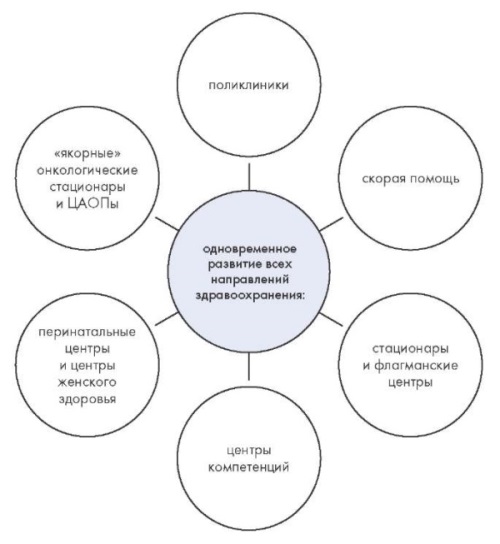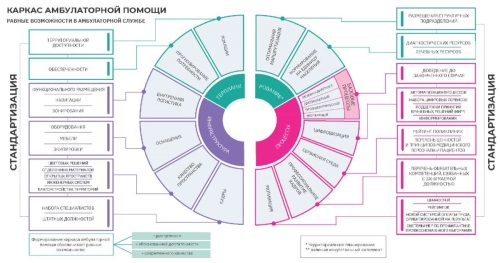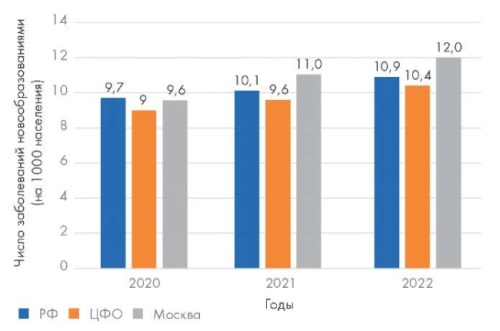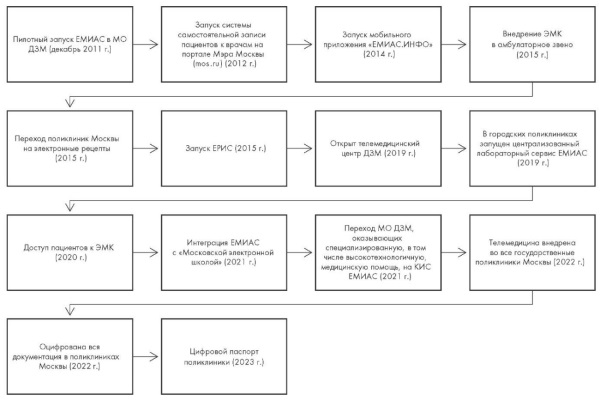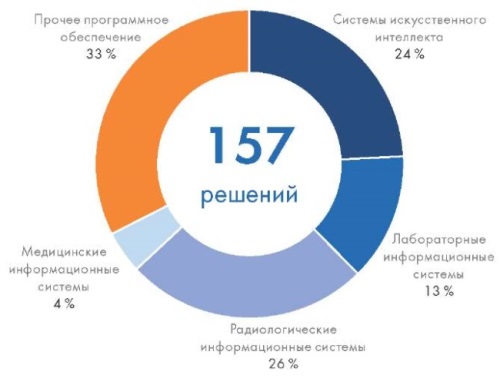НEALTHCARE ORGANIZATION
In modern socio-political and socio-economic conditions, the task of preserving, strengthening and improving the health of the population of any city, especially the capital, is becoming extremely relevant and important. The capital’s healthcare system implements a state policy in the field of healthcare, providing the necessary conditions for providing citizens with affordable and high-quality medical care.
Aim. Describe the main approaches to the modernization of Moscow healthcare, taking into account the pace of development of the megalopolis infrastructure and the needs of its residents in high-quality and affordable medical care.
Materials and methods. The analysis of the general morbidity and by classes of diseases, the average number of visits per resident per year by disease, resource provision and activities of medical organizations subordinate to the Moscow Healthcare Department according to federal forms of statistical observation for 2018–2022 was carried out.
Results. Against the background of an increase in the general morbidity of adults in the Russian Federation (by 10.4 %), a similar trend is observed in Moscow (by 4.8 % in 2022 compared to 2021). Currently, a number of projects aimed at transforming and modernizing the current healthcare system are being implemented in the capital, thanks to the implementation of which in recent years Moscow has managed to achieve the targets of the Capital Healthcare program and significantly exceed similar national averages – for the period 2010–2022, life expectancy has increased from 74.2 years to 78.2 years; for the period 2018–2022, primary morbidity has significantly decreased (for example, diseases of the digestive system – by more than 28 %, diseases of the musculoskeletal system – by more than 30 %); waiting time for admission by a doctor in the polyclinic network has been reduced by 3.3 times. Including an increase in the average number of visits per resident (8.4) compared to 2018 – by 3.7 %.
Conclusion. Modernization of the capital’s medicine is carried out at the level of technical equipment, staffing and organizational solutions. New management technologies include an integrated approach to infrastructure modernization, building scalable processes and maximum automation, which requires both an integrated approach within the Moscow Healthcare Department and intersectoral cooperation.
The increase in the number of chronic noncommunicable diseases, changes in the age structure of the population, and an increase in demand for medical services in the primary health care system determine the need for an adequate response of health systems to these requests. Standardization is one of the effective mechanisms for managing the quality and accessibility of medical care provided to the population. The development of the Moscow healthcare system today is focused on the redistribution of forces towards primary healthcare and large-scale digitalization.
Aim. To evaluate the results of the implementation of standardized solutions in the primary health care management system provided in outpatient clinics subordinate to the Department of Health of the city of Moscow.
Materials and methods. Statistical and analytical methods, the method of expert interviews and content analysis of literature sources of domestic authors, as well as normative legal acts for 2018-2023 were used in the work. The main performance indicators of the outpatient clinics of Moscow are analyzed.
Results. Important purposes of the healthcare system have been achieved: the created modern framework of outpatient care provided the opportunity to ensure equal access to quality care; the introduction of a single standard of polyclinics contributes to the rationalization of territorial planning, improvement and development of infrastructure, the use of innovative medical technologies and solutions; managerial and reorganization changes in the structure of polyclinics allowed to build convenient and clear routing of patients to receive medical care in the required volume and shorter terms. Changes in the Moscow primary health care system affect both external and internal processes, are aimed at maximizing the coverage of the population with health services, improving the provision of modern equipment to Moscow polyclinics, and creating a digital polyclinic.
Conclusion. Bringing Moscow polyclinics to a single standard required reengineering of existing processes, restructuring of procedures focused on managing the completed case. The quality and accessibility of medical care to the population of Moscow remains a top priority in the development of outpatient care.
The large-scale transformation of the capital’s healthcare system included the creation of competence centers to provide citizens with affordable and high-quality medical care in the most popular fields, including oncology. To provide medical care to patients with neoplasms in a full cycle, outpatient cancer care centers were included in the structure of cancer centers.
Aim. To analyze Moscow’s experience in launching competence centers using the example of creating outpatient cancer care centers.
Materials and methods. In the course of the research, a content analysis of literary data and regulatory legal acts of the Moscow Healthcare Department was used. The analysis of indicators of primary morbidity of the entire population (A00-T98) and by class of neoplasm (C00-D48) in Russia as a whole, the Central Federal District according to Rosstat and Moscow. A sociological method was used in the form of a survey and questionnaire of patients.
Results. The number of all registered diseases in the medical organizations of the Moscow Healthcare Department in 2022 amounted to 752.4 cases per 1000 population, which is lower than in Russia and the Central Federal District. The number of registered malignant neoplasms in 2022 was 12.0 cases per 1000 population, which is higher than the average for Russia and the Central Federal District. In Moscow, in 2022, for the first time, 65 % of patients with malignant neoplasms detected at stages I and II were registered at the dispensary. The proportion of patients registered for 5 years or more in 2022 was 58.7 %.
Conclusion. At the moment, the system of organization of oncological care is a set of structures that combine all stages of care: from diagnosis to follow-up. Monitoring of diagnostic and treatment results at the level of the patient and the entire organization as a whole is carried out continuously and is the basis for evaluating the achievement of performance indicators.
INFORMATIZATION OF HEALTHCARE
The modern appearance of the Moscow digital clinic was mainly set in 2011 in the context of complex changes in the city management system, which subsequently took the form of the Moscow city development concept “Smart City – 2030”. The initial goals for changing primary health care included providing Muscovites with access to information and communication technologies in medical organizations, eliminating fragmentation and duplication of functions, and ensuring compatibility of data used in various information systems.
Aim. To identify and describe step-by-step changes in the organization of primary health care in Moscow, related to the introduction of digital technologies and aimed at improving the organizational forms and methods of operation of public medical institutions in the capital, improving the access of the urban population to timely and high-quality medical care.
Materials and methods. An analysis of regulatory legal acts and scientific literature was carried out in the “manual search” mode for the period 2011–2024.
Results. Informatization of key processes in primary healthcare in the capital has reduced the waiting time for patients to receive an appointment. The number of people waiting 4 days or more to see a therapist has dropped to 2 %. An AIDS based on artificial intelligence was introduced into the practice of primary care doctors, available in all adult clinics in Moscow. Telemedicine services were provided for patients with COVID-19, which were subsequently expanded to other categories of patients.
Conclusion. A review of data related to the digitalization of healthcare shows that changes in the work of clinics of the Moscow public health system are best practices that correspond to the practices of leading foreign countries, partly surpassing them in the systematicity of urban management issues.
According to the recommendations of The International Medical Device Regulators Forum (IMDRF), software intended for medical purposes falls under the category of medical devices (MD). In recent years, in Russia, a great deal of systematic work has been carried out to establish normative regulations and processes for controlling the efficiency and safety of
software as medical devices (SaMD) and its subsequent state registration.
Objective. The analysis of current procedures and results of state registration of SaMD in the Russian Federation in 2007–2024.
Materials and methods. A systematic search of information on the software registered in Russia as MD was carried out. For this, the state registry of MD of the Federal Service for Surveillance in Healthcare of Russia (Roszdravnadzor) was used. 157 records of marketing authorizations (MA) issued between 01. 01. 2007 and 30. 07. 2024 were found.
Results. 25.5 % of MAs were issued for radiological information systems, including image archiving and communication systems (PACS-systems). For SaMD with artificial intelligence technologies – 24.2 % MAs. 13.4 % of MAs were issued for laboratory information systems and 4.5 % for medical information systems of medical organizations. The “Other software” group accounted for 32.5 %, it included telemedicine solutions, software for planning surgeries, etc. More than 50 % of Mas for SaMD was issued for Russian-based developers. Half of SaMD was registered as the 2nd class of potential risk application (50 %), 17 % as the class 2b, and 18 % as the lowest 1st class of potential risk. 15 % of SaMD were of the maximum 3rd class of the potential risk of application, and most of them were SaMD with artificial intelligence (AI) technologies.
Conclusion. In Russia, a system of independent testing and state registration of SaMD has been built and has been working reliably for many years, allowing manufacturers to bring to the market the most diverse products, including innovative AI-based MD. Russian development companies are gradually increasing their market share compared to foreign producers.
LEGAL ACTS
ISSN 2713-0703 (Online)



